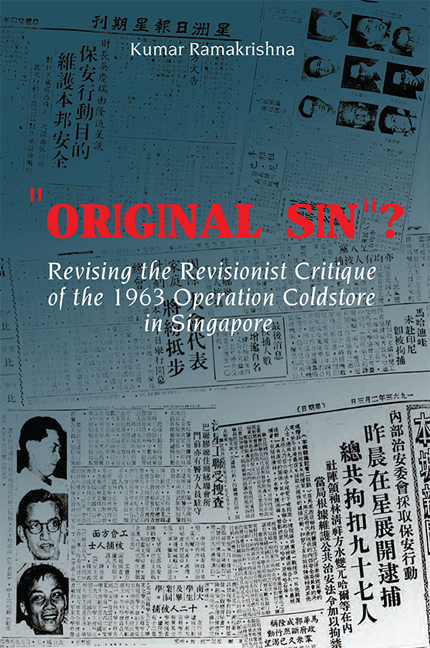Book contents
- Frontmatter
- Contents
- Acknowledgements
- Introduction: The “Alternate” Challenge to the Singapore Story as Context
- 1 Government Sources: Who Uses Them, and the Alternates’ Unarticulated Ideological Outlook
- 2 Was there Really a Dangerous Communist United Front?
- 3 The Curious Case of Lim Chin Siong
- 4 Why “Was Operation Coldstore Driven by Political and Not Security Grounds?” is the Wrong Question
- Conclusion: The Enduring Need for a Singapore Story 2.0
- Bibliography
- Index
- About the Author
2 - Was there Really a Dangerous Communist United Front?
Published online by Cambridge University Press: 19 May 2017
- Frontmatter
- Contents
- Acknowledgements
- Introduction: The “Alternate” Challenge to the Singapore Story as Context
- 1 Government Sources: Who Uses Them, and the Alternates’ Unarticulated Ideological Outlook
- 2 Was there Really a Dangerous Communist United Front?
- 3 The Curious Case of Lim Chin Siong
- 4 Why “Was Operation Coldstore Driven by Political and Not Security Grounds?” is the Wrong Question
- Conclusion: The Enduring Need for a Singapore Story 2.0
- Bibliography
- Index
- About the Author
Summary
While Alternates like Thum Ping Tjin go so far as to declare that the “historiography is clear on the lack of evidence of communism” in Singapore's post-war history, most voices within the Alternate constituency argue instead that while the Communist Party of Malaya (CPM) organization was “central to the left”, and its “cadres played a pivotal part in trade unionism and popular front politics”, its role has nevertheless been exaggerated in the Singapore Story. T.N. Harper for instance argues that the insurrection “now seems like a concatenation of forces from below”, over which the CPM “exercised little direction”. For their part Loh Kah Seng and Michael Fernandez insist that it is “simplistic to blame the violence” perpetrated by leftist unions in the mid-1950s “solely on communist instigation”. The former leftist Dominic Puthucheary, challenging the oft-quoted metaphor in the Singapore Story that Lee Kuan Yew had to “ride the Communist Tiger” to power in Singapore, articulated the Alternate position well:
Was there really a tiger? Did the tiger want to swallow anybody? Or was there a movement with a wide range of political views from extreme left to social democratic right which attempted to create an alternative to a colonially-designed society, an embryo for creating a new Malaya?
The sum total of the Alternate position, therefore, is that while there certainly was an anti-colonial Progressive Left movement in Singapore in the 1950s to early 1960s, this was not necessarily one that was closely directed by the CPM behind the scenes. Hence Harper suggests that the “very idea of a ‘Communist United Front’ is perhaps a misnomer: most of the groups caught up in leftist popular radicalism” were “neither communist, united, nor a front for anybody but themselves”. Michael Barr and Carl Trocki echo this assessment, arguing that while the CPM “could offer moral and spiritual leadership, the party on the ground in Singapore had little influence over everyday events”, and that “[s]tudent and labour movements, strikes and demonstrations were often the result of spontaneous actions by the individuals directly involved”.
- Type
- Chapter
- Information
- Original Sin?Revising the Revisionist Critique of the 1963 Operation Coldstore in Singapore, pp. 23 - 71Publisher: ISEAS–Yusof Ishak InstitutePrint publication year: 2015



